Welcome to my annual coverage of the K2 summer climbing season. I will be reporting from my home in Colorado this year based on my personal experience of our successful 2014 K2 summit and covering the action the last four years.
I try to report on K2 in the same style as my annual Everest coverage but accurate information is much more difficult to obtain from Northern Pakistan than from Nepal. I’ll do my best to throw in occasional coverage for climbers on Broad Peak, Nanga Parbat and Gasherbrum I and II. Currently there are 391 people scheduled to be climbing in the Karakorum this summer with 164 just on K2.
As always, I use my blog to raise awareness of Alzheimer’s and if you appreciate my coverage, please consider a donation where 100% goes to Alzheimer’s non-profits and nothing ever to me. Read more about why this cause is so important at this link and how Alzheimer’s took Ida Arnette’s life.
The Savage Mountain
As I discussed in a post a few years ago, “Why K2 will not become Everest“, K2 is a totally different climbing experience requiring a honed set of skills and alpine experience. It is the second highest mountain in the world at 28,251’/8611m and remains the only 8000er not summited in winter. While 164 people climbing K2 is a large number, it is dwarfed by the nearly 1,000 who attempted Everest this spring.
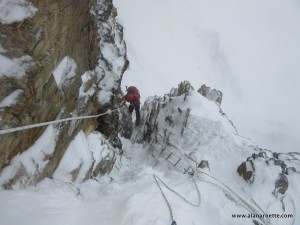
Climbing K2 is technical – meaning you are using feet and hands to climb; the exposure is dramatic – meaning if you fall you will most likely die; and the weather is extreme – meaning it is less predictable due to standing alone to the west of nearby mountains thus creating its own systems. It is common to have very different conditions on K2 than on Broad Peak or the Gasherbrums that are only a few miles away.
Unlike Everest, there are no long, flat sections i.e. the Western Cwm. K2 starts steep, ends steep and never lets up. Objective dangers are constantly on the minds of K2 climbers. Avalanches and rock-fall are rampant and injuries are common. These are not bravado or ego-based comments on my part given I have summited both peaks, but my effort to help readers understand that K2 is in a different league than most of the other 8000ers. Just because you summited Everest, doesn’t mean you are ready for K2. A bit of trivia, there are less than 200 people who have summited both Everest and K2.
It is well documented that K2 sees significantly more deaths than Everest. Thru the spring of 2019, I estimate 9,950 summits by about 6,000 people and 306 deaths on Everest – 3% compared to 379 summits with 85 deaths on K2 – 22%. Of the 8000 meter peaks, Everest has the highest absolute number of deaths at 306 but ranks near the bottom with a death rate of 1.13. Annapurna is the most deadly 8000er with one death for about every three summits (72:293) or a 3.71 death rate. Cho Oyu is the safest with 3,681 summits and 50 deaths or a death rate of 0.55.
While some will quibble with these statistics, it is a measure of risk. The number one reason listed for death on K2 is “disappearance” suggesting that the climber fell in a highly exposed area, was blown away by winds or buried in an avalanche. 33 climbers have died while descending from the summit. 11 died in 2008 including my friend Gerard McDonnell when the towering ice serac just below the summit let a tiny fraction of its 100 meter vertical face loose. If you attempt K2, you must accept that dying is a real possibility.

Years with No K2 Summits
The first summit of K2 was on July 31, 1954, by Italians Lino Lacedelli and Achille Compagnoni. The first attempts began in 1902 by Brit Aleister Crowley. But it was the Duke of Abruzzi who made the most valiant attempts in the early 1900’s thus named the ridge most popular used today, the Abruzzi Spur. After five separate American attempts, Louis Reichardt and Jim Wickwire summited on September 6, 1978, and John Roskelley and Rick Ridgeway the next day. Amazingly Jim Wickwire spent a night in the open just below the summit at 27,000 feet without food, oxygen, or shelter in temperatures of -40 degrees.
According to research, plus my own research, from 1986 to 2018 there were 12 years with no summits. From 2009 to 2018, there were only five years with summits – 2011 only from the Chinese side by Gerlinde Kaltenbrunner who became the first woman to get all the 8000ers san Os. In 2012, 2014 and 2018 each saw about 30 – 50 people summiting – record-breaking years as a result of a week of excellent and rare summit conditions. Everest went from 1974 to 2014 with summits every year – 40 straight years! The best year ever for K2 was last year, 2018 with 62 total summits followed by 2004 with an estimated 51 summits.
2018 K2 Results
2018 was a record year on K2 with over 60 total summits plus the first true ski descent. The Kathmandu based and Sherpa owned guide company, Seven Summits Treks (SST), used their Everest formula to put 24 people on the summit on July 21st made up of 10 members supported by 13 Sherpas and 1 HAP. This is becoming a familiar formula to commercialize K2 – a 2:1 member to support ratio and plenty of supplemental oxygen and wait for 4 days of good weather. This happened in 2014 and again in 2018 when about 50 people summited. Also on July 21st, there were seven other people who summited taking the day’s total to 31.
2018 was a good year for female K2 climbers with six women including Gangaamaa Badamgarav who became the first Mongolian to summit K2 as well as the first female from her country. Other females summiting were American Lisa Thompson, Chinese Jianhong Li, Japanese Naoko Watanabe, Mexican Viridiana Chavez (first Latin woman), Swiss climber Sophie Lavaud summited and Yuki Inayoshi with Karakorum Expeditions
Tragedy struck on July 7th, when Canadian climber Serge Dessureault fell to his death on K2 near House Chimney as he was rappelling from Camp 2 during an acclimatization rotation. He was the leader of a small Canadian team that soon after canceled their expedition and returned home.
Polish climber/Skier Andrzej Bargiel caught the world’s attention when he ascended K2 via the Česen Route then skied from the summit taking a maze of routes: Abruzzi Rib, the Česen, the Messner variant and the Kukuczka-Piotrowski to base camp – it was the first direct ski from summit to base of K2 ever. He summited Sunday, 22nd July at 11:30am and reached the Base Camp at around 7:30pm local time. His brother filmed the feat with a drone. This is mind blowing, jaw-dropping footage
2017 K2 Results
2017 was a mixed year on K2 with most teams choosing not to risk a summit push but one strong Sherpa team gambled and made it for the first summits since 2014. Lead by Mingma Gyalje Sherpa, 31, founder of the Nepali guide company Dreamers Destination, now Imagine Climb. This was the second time he has guided a team to the summit, 2014 was his first. Long-time legend Russell Brice’s Himex team attempted the Česen route but stopped due to dangerous conditions and all the other teams on the Abruzzi stopped their attempts after an avalanche wiped out Camp 3 and Advanced Base Camp burying most of their gear.
Of course, K2 saw a rare winter attempt just six months ago. It ended poorly with botched logistics, in-fighting within the team and just plain old bad luck with the weather and snow conditions. As if that was not enough, several members of the Polish team left K2 in the middle of their acclimatization work for a rescue mission on nearby Nanga Parbat. You can read my full coverage of these events at this link.
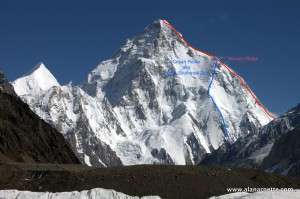
Routes
There are 9 named routes on K2: Česen, Northeast Ridge, North Ridge, South Face (Central Rib), South-southwest Pillar (Magic Line), Northwest Face, Northwest Ridge and West Face with the Abruzzi Spur aka the Southeast Ridge. No one has climbed the East Face, due to the instability of the snow and ice formations on that side. There are no easy routes on K2.
The Abruzzi has been used for 75% of the summits. There are several technically difficult features including Houses’ Chimney, and the Black Pyramid. The Bottleneck Couloir is one of the most dangerous sections serving as a blowing alley for rock and ice fall. The Abruzzi usually has 4 camps on the mountain:
- Base Camp: 18,600ft/5669m
- Advanced Base Camp: 18,650ft/5684m
- Camp 1: 19,965’/6085m
- Camp 2: 22,110’/6740m
- Camp 3: 23,760’/7240m
- Camp 4: 25,080’/7644m
- Summit: 28,251’/8611m
2019 Teams
As usual, K2 will dominate the climbing with approximately 97 foreigners registered for permits, this does not include Sherpas or HAPs which could be an equal amount of climbers so look for about 200 people on K2. The combo Broad Peak with K2 has 58 permits while BOP stand alone has 38.
The Gasherbrums are always popular, especially GI (8086M) & GII (8035M). There are 84 permits issued for them. The other peaks to be attempted this summer include:
- Link Sir (7041m)
- Dansam
- K-6 (7282m)
- Sherpi Kangri (7380m)
- Latok 1 (7151m M)
- Tahu Ratm
- Spantik Peak (7027M)
- Distaghil Sar (7885m)
- Urdo Kangri II
- Rakaposhi – 7788m
- Bula Rang Sar – 4913m
- Sani Pakush
- Latok Chokati
- Pumari Chhish -7492m
- Muztagh Tower – 7273m
- Liala Peak -6986m
I will not be keeping a location table like I do for Everest given the lack of detailed information. These are the teams reported to have climbing permits for the Karakorum this summer in Pakistan. Keep in mind that all foreign operators must use a local Pakistani owned and operated company to obtain permits. Also they have been required to hire Pakistani High Altitude Porters and discouraged from bringing Sherpas from Nepal/Tibet to support their teams, however many teams do albeit at a higher expense.
A few of the teams are back after being stopped in prior years. Maddison Mountaineering has a large team of 22 members. Dan Mazzur’s Summit Climb has eight for Broad Peak/K2 as does Furtenbach with 11. Seven Summits Treks is there providing logistics for many of the other teams in addition to having a huge 42 on their own K2 team.
Adrian Ballinger is attempting K2 without supplemental oxygen, He is joined by Ecuadorean Topo Mena 13 other members. Mingma Gyalje Sherpa, of the Nepali guide company Imagine Climb has 31 members for K2.
- Madison Mountaineering
- Furtenbach Adventures
- Imagine Climb
- Adventure Peaks
- Adventure Tours Pakistan
- Karakorum Tours Pakistan (Manzoor Ahmad)
- Karakorum Expeditions (Mirza Ali )
- Nazir Sabir Expeditions
- Seven Sumits Treks
- Summit Climb
- Himalayan Experience (Himex) – scheduled but not confirmed
Many teams have arrived in Pakistan and are making the 8 day hike up the Baltoro Glacier enjoying some of the most spectacular views anywhere in the mountains.
Climbers with social media that appear to be updated include:
- Reinhold Messner’s son, Simon Messner, is looking a new route somewhere near Muztagh Tower
- Mike Horn is back for his third att smtp on K2. Fred Roux is his partner this time
- Sergi Mingote looking at both GI and GII
- Russians Vitaly Lazo and Anton Pugovkin want to ski the Diamir Face on Nanga Parbat
- Fredrik Sträng – K2 for his 3rd or 4th time.
- Denis Urubko and María José Cardell are investigating she new climbs this summer but no specifics yet
Finally Nirmal Purja Purja (Nirmal Purja Purja Purja) Purba who made his name with that famous picture of the line at the Hillary Step last month had to postpone his project to get all 14 8000ers in 7 months due to lack of sponsors. He said he may resume in month.
And the Other 8000ers
Gasherbrum I/II
At 26,362’/8035m. GII is often considered the most attainable of the Karakoram’s 8000ers. There have been about 350 summits of GI and 940 of GII.
Nanga Parbat
Russians Vitaly Lazo and Anton Pugovkin want to ski the Diamir Face on Nanga Parbat
Broad Peak
BP is often considered a warm-up for K2 but that grossly understates the difficulty of this 26,414’/8051m peak. About 425 people have summited Broad. Every season people talk about summiting both but it is rarely accomplished as I described in this post last year. The most recent double for Broad Peak and K2 was Sergi Mingote in 2018, without supplemental oxygen. Before that was in 2014 by Bulgarian climber Boyan Petrov. I passed him descending from the summit as he was going up near Camp 2. He was young, strong and confident so I wasn’t surprised to learn he had summited. Sadly, he perished on Shishapangma this year.
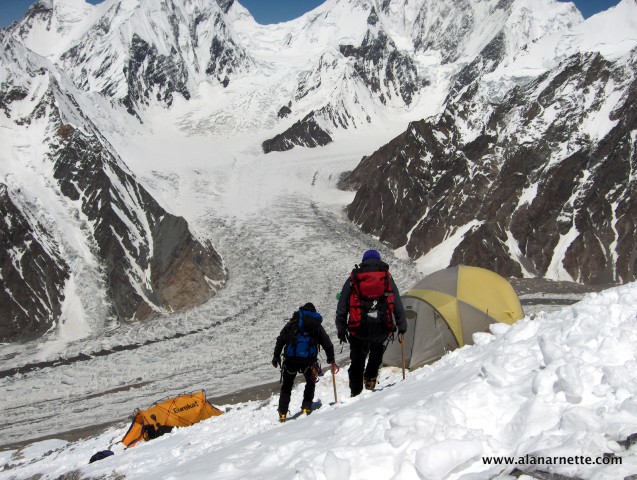
If you are wondering about summer climbing in Nepal and Tibet where the other nine 8000ers are located, the summer monsoons usually prevent that. The monsoonal flow avoids hitting Northern Pakistan in July and August, but that pattern has been known to change as was experienced in 2015 and 2016.
Schedule
Everything starts in Islamabad, then the drive to Askole, the trek to base camps and the climb begins. This is a typical schedule:
- June 15: Islamabad
- June 18 – June 28: Trek to BC on Baltoro Glacier
- June 29 – July 15: Establish High Camps and Acclimatize
- July 15 – Aug 31: Summit Bid
- July 31 – Aug 5: Travel Out
A Busy Summer in Pakistan
If you have a team and want coverage, please contact me. Best of luck to all this summer. Hoping the winds are not as strong as they were on Everest last month and the K2 climbers nab a summit or two.
Climb On!
Alan
Memories are Everything

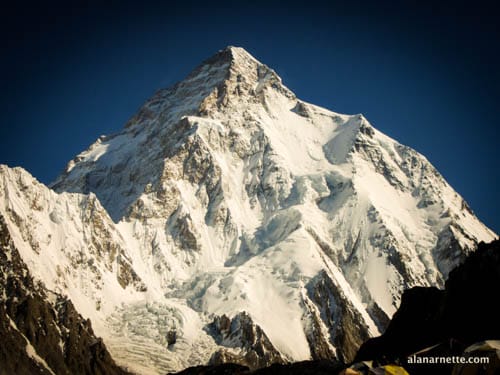

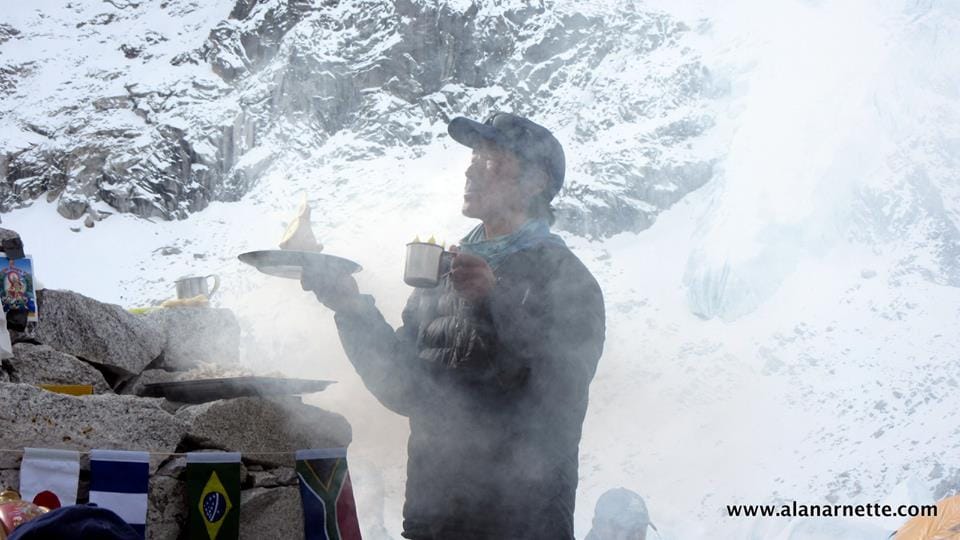

2 thoughts on “K2 2019 Summer Season Coverage”
What is the distance in feet from the base of the mountain to the top? Thanks for all your coverage, it is very interesting!
Thank you for your detailed reports and statistics. K2 has attracted lots of climbers to go for it. I wonder if the little space for high camps would make the climb very crowd, combing the short window for summitting. One of my friend have joined Mingma G’s group and would try the combo Broad Peak with K2. Wish him and all climbers enjoy the exploring and come home safely.
Comments are closed.